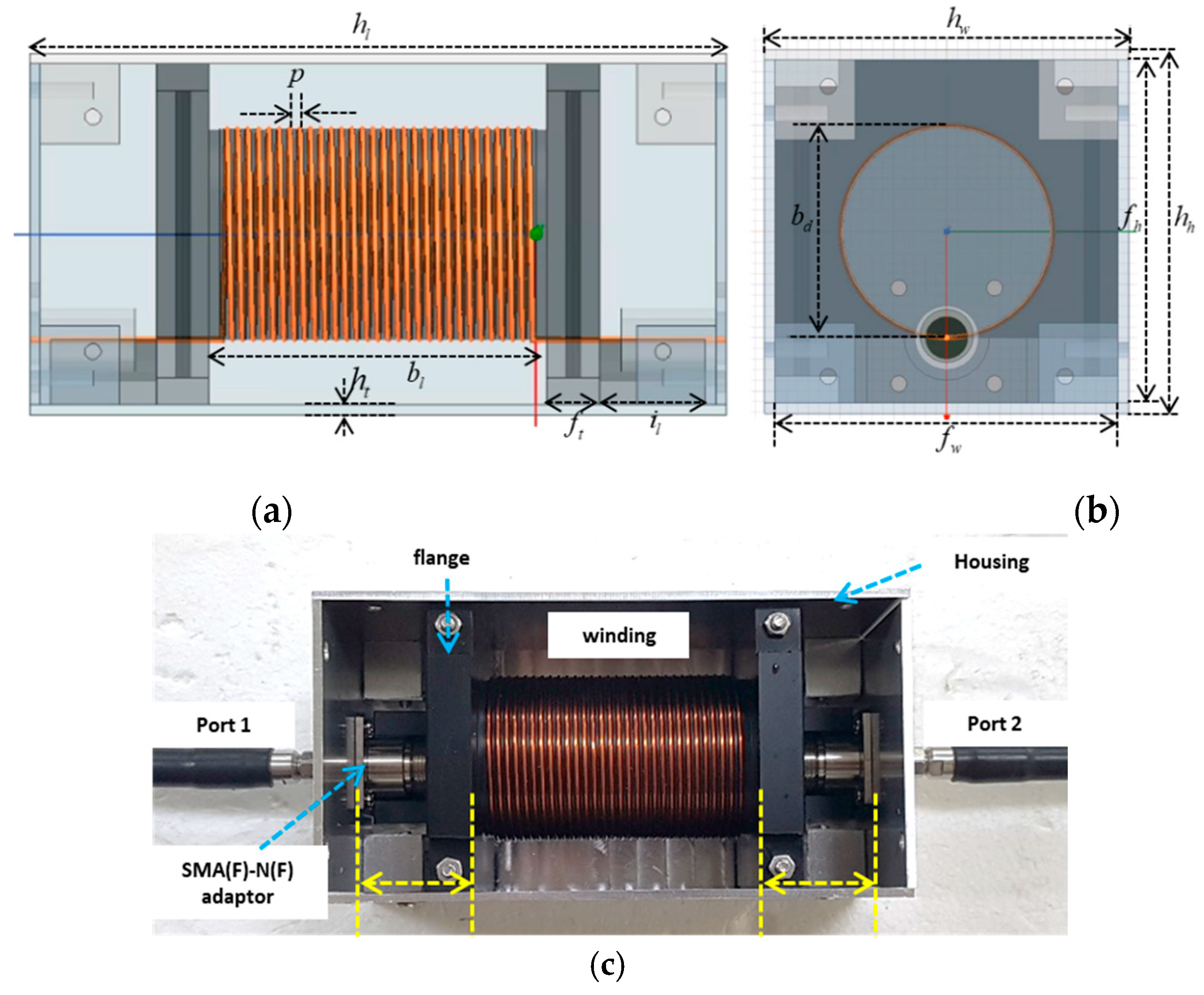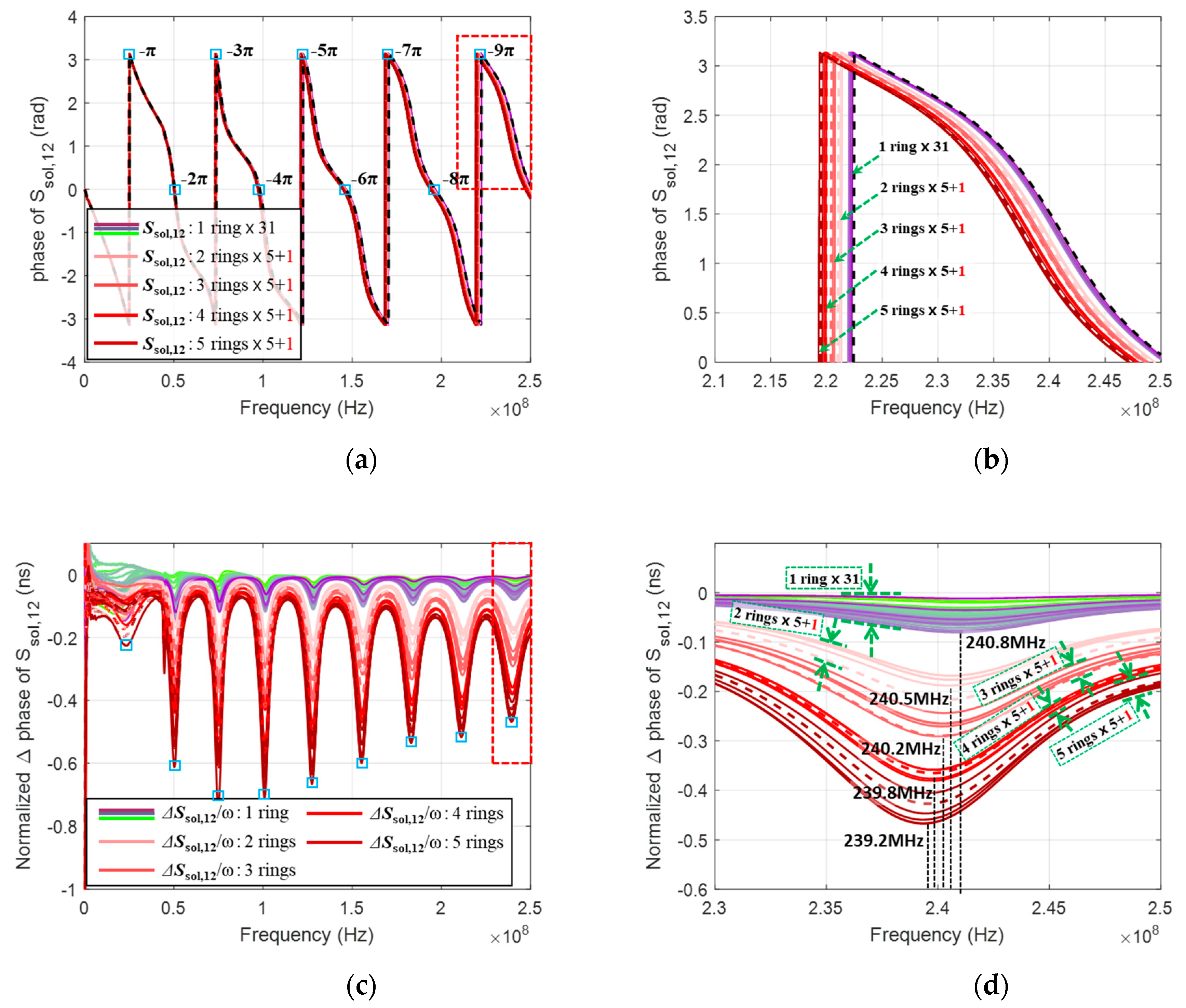Quantitative Analysis of Insulator Degradation in a Single Layer Solenoid by Renormalization of the Transmission Parameter
Abstract
1. Introduction
2. A Transmission Line Model Including a Locally Degraded Part Inside
2.1. Discontinuous Transmission Line Model Mimicking Deterioration of the Insulator
2.2. Changes in Permittivity of the Transmission Parameter
2.3. Renormalization Technique of an S-Parameter
3. Fabrication and Measurement Setup for a Prototype of Single-Layered Solenoid
3.1. Structure of a Prototype Single-Layered Solenoid
3.2. Setup for Experimental Measurement and De-Embedding Interfaces
3.3. Setup for Mimicking Degraded Insulator in the Prototype Solenoid
4. Detection of Insulator Degradation in Solenoid Using S-Parameters
Quantitative Detection of Insulator Degradation Using Renormalized S-parameters
5. Conclusions
Author Contributions
Funding
Conflicts of Interest
Abbreviations
| AWG | American Wire Gauge |
| GW(e) | Gigawatt electrical |
| IAEA | International Atomic Energy Agency |
| NPP | Nuclear power plant |
| RF | Radio frequency |
| S-parameters | Scattering parameters |
| S11 parameters | Input port voltage reflection coefficient in two-port network |
| S12 parameters | Reverse voltage gain in two-port network |
| S21 parameters | Forward voltage gain in two-port network |
| S22 parameters | Output port voltage reflection coefficient in two-port network |
| SOLT | Short-open-load-thru |
| SOV | Solenoid operated valve |
| VNA | Vector network analyzer |
| ZC | Characteristic impedance of the transmission line |
| Z0 | Reference impedance of the ports |
| Zin | Input impedance from the end of solenoid to port |
| β | Propagation constant of the transmission line |
| εeff | Effective permittivity |
| Γ | Matrix of the reflection coefficient from each port |
| td | Delay time |
| vp | Phase velocity |
References
- World Nuclear Association. World Nuclear Performance Report; World Nuclear Association: London, UK, 2020. [Google Scholar]
- International Atomic Energy Agency. Operating Experience with Nuclear Power Stations in Member States in 2019; International Atomic Energy Agency: Vienna, Austria, 2019. [Google Scholar]
- Varga, I.; Bartha, T.; Szabó, G.; Kiss, B. Status and Actual Risk Monitoring in a NPP Reactor Protection System. In Probabilistic Safety Assessment and Management; Springer: Berlin/Heidelberg, Germany, 2004; pp. 2654–2659. [Google Scholar]
- Upadhyaya, B.R.; Eryurek, E. Application of neural networks for sensor validation and plant monitoring. Nucl. Technol. 1992, 97, 170–176. [Google Scholar] [CrossRef]
- Ma, J.; Jiang, J. Applications of fault detection and diagnosis methods in nuclear power plants: A review. Prog. Nucl. Energy 2011, 53, 255–266. [Google Scholar] [CrossRef]
- Gong, Y.; Su, X.; Qian, H.; Yang, N. Research on fault diagnosis methods for the reactor coolant system of nuclear power plant based on D-S evidence theory. Ann. Nucl. Energy 2018, 112, 395–399. [Google Scholar] [CrossRef]
- Kwon, K.-C.; Kim, J.-H. A Stochastic Approach with Hidden Markov Model for Accident Diagnosis in Nuclear Power Plants. In Industrial and Engineering Applications of Artificial Intelligence and Expert Systems: Proceedings of the Tenth International Conference; CRC Press: Boca Raton, FL, USA, 2020. [Google Scholar]
- Wang, H.; Peng, M.-J.; Hines, J.W.; Zheng, G.-Y.; Liu, Y.-K.; Upadhyaya, B.R. A hybrid fault diagnosis methodology with support vector machine and improved particle swarm optimization for nuclear power plants. ISA Trans. 2019, 95, 358–371. [Google Scholar] [CrossRef] [PubMed]
- Ikonomopoulos, A.; Tsoukalas, L.H.; Uhrig, R.E.; Mullens, J.A. Monitoring nuclear reactor systems using neural networks and fuzzy logic. In Proceedings of the American Nuclear Society (ANS) Topical Meeting on Advances in Reactor Physics, Charleston, SC, USA, 8–11 March 1992. [Google Scholar]
- Jameson, N.J.; Azarian, M.H.; Pecht, M.; Wang, K.; Aidong, X. Electromagnetic coil equivalent circuit model sensitivity analysis for impedance-based insulation health monitoring. In Proceedings of the 2017 Prognostics and System Health Management Conference (PHM-Harbin), Harbin, China, 9–12 July 2017; pp. 1–6. [Google Scholar]
- Jameson, N.J.; Azarian, M.H.; Pecht, M. Improved electromagnetic coil insulation health monitoring using equivalent circuit model analysis. Int. J. Electr. Power Energy Syst. 2020, 119, 105829. [Google Scholar] [CrossRef]
- Jameson, N.J.; Azarian, M.H.; Pecht, M. Fault diagnostic opportunities for solenoid operated valves using physics-of-failure analysis. In Proceedings of the 2014 International Conference on Prognostics and Health Management, Cheney, WA, USA, 22–25 June 2014; pp. 1–6. [Google Scholar]
- Rahman, M.; Cheung, N.; Lim, K.W. A sensorless position estimator for a nonlinear solenoid actuator. In Proceedings of the IECON ’95—21st Annual Conference on IEEE Industrial Electronics, Orlando, FL, USA, 6–10 November 1995; p. 2. [Google Scholar]
- König, N.; Nienhaus, M. A Solution to Ambiguities in Position Estimation for Solenoid Actuators by Exploiting Eddy Current Variations. Sensors 2020, 20, 3441. [Google Scholar] [CrossRef] [PubMed]
- Wu, S.; Zhao, X.; Li, C.; Jiao, Z.; Qu, F. Multiobjective Optimization of a Hollow Plunger Type Solenoid for High Speed On/Off Valve. IEEE Trans. Ind. Electron. 2017, 65, 3115–3124. [Google Scholar] [CrossRef]
- Zhijian, J.; Minglin, Z.; Zishu, Z. Fault location of transformer winding deformation using frequency response analysis. In Proceedings of the 2001 International Symposium on Electrical Insulating Materials (ISEIM 2001). 2001 Asian Conference on Electrical Insulating Diagnosis (ACEID 2001). 33rd Symposium on Electrical and Electronic Insulating Materials and Applications in System, Himeji, Japan, 22–22 November 2001; pp. 841–844. [Google Scholar]
- Pozar, D.M. Microwave Engineering; John Wiley & Sons: Hoboken, NJ, USA, 2009. [Google Scholar]
- Frei, J.; Cai, X.-D.; Muller, S. Multiport S-Parameter and T-Parameter Conversion with Symmetry Extension. IEEE Trans. Microw. Theory Tech. 2008, 56, 2493–2504. [Google Scholar] [CrossRef]
- Lu, H.-C.; Chu, T.-H. Multiport scattering matrix measurement using a reduced-port network analyzer. IEEE Trans. Microw. Theory Tech. 2003, 51, 1525–1533. [Google Scholar] [CrossRef]
- Chen, C.-J.; Chu, T.-H. Accuracy Criterion for S-Matrix Reconstruction Transforms on Multiport Networks. IEEE Trans. Microw. Theory Tech. 2011, 59, 2331–2339. [Google Scholar] [CrossRef]
- Kurokawa, K. Power Waves and the Scattering Matrix. IEEE Trans. Microw. Theory Tech. 1965, 13, 194–202. [Google Scholar] [CrossRef]
- Diaham, S.; Locatelli, M.-L. Dielectric properties of polyamide-imide. J. Phys. D Appl. Phys. 2013, 46, 185302. [Google Scholar] [CrossRef]
- Frankel, S. Characteristic Impedance of Parallel Wires in Rectangular Troughs. Proc. IRE 1942, 30, 182–190. [Google Scholar] [CrossRef]
- Arvia, E.M.; Sheldon, R.T.; Bowler, N. A capacitive test method for cable insulation degradation assessment. In Proceedings of the 2014 IEEE Conference on Electrical Insulation and Dielectric Phenomena (CEIDP), Des Moines, IA, USA, 19–22 October 2014; pp. 514–517. [Google Scholar]
- Tanaka, T. Aging of polymeric and composite insulating materials. Aspects of interfacial performance in aging. IEEE Trans. Dielectr. Electr. Insul. 2002, 9, 704–716. [Google Scholar] [CrossRef]
- Kim, K.; Shin, J.; Kim, B.-S.; Nah, W.; Lim, C.; Chai, J. Electrical and mechanical diagnosis of aging 600 V rated STP cables in a nuclear power plant. IEEE Trans. Dielectr. Electr. Insul. 2017, 24, 1574–1581. [Google Scholar] [CrossRef]
- Asipuela, A.; Mustafa, E.; Afia, R.S.A.; Adam, T.Z.; Khan, M.Y.A. Electrical Condition Monitoring of Low Voltage Nuclear Power Plant Cables: Tanδ and Capacitance. In Proceedings of the 2018 International Conference on Power Generation Systems and Renewable Energy Technologies (PGSRET), Islamabad, Pakistan, 10–12 September 2018; pp. 1–4. [Google Scholar]










| Design Parameter | Length (mm) | Description | Design Parameter | Length (mm) | Description |
|---|---|---|---|---|---|
| fh | 64.5 | flange height | hh | 68.5 | housing height |
| fw | 64.5 | flange width | hw | 68.5 | housing width |
| ft | 10 | flange thickness | hl | 132 | housing length |
| bl | 64 | bobbin length | ht | 2 | housing thickness |
| bd | 40 | bobbin diameter | il | 20 | interface length |
| p | 2 | pitch of winding | - | - | - |
| No. of Rings | Ring Location | No. of Rings | Ring Location |
|---|---|---|---|
| 0 | None (healthy) | 3 | r3–5, r9–11, r15–17, r21–23, r27–29, r3,16,29 |
| 1 | r1, r2,…, r30, r31 | 4 | r2–5, r8–11, r14–17, r20–23, r26–29, r3,11,20,29 |
| 2 | r3–4, r9–10, r15–16, r21–22, r27–28, r3,29 | 5 | r1–5, r7–11, r13–17, s19–23, r25–29, r3,8,16,23,29 |
| No. of Rings | 0 (Healthy) | 1 | 2 | 3 | 4 | 5 |
|---|---|---|---|---|---|---|
| εeff at π, f (MHz) | 2.503, (25.16) | 2.512, (25.16) | 2.517, (25.00) | 2.519, (25.00) | 2.528, (25.00) | 2.530, (25.00) |
| εeff at 2π, f (MHz) | 2.484, (50.47) | 2.506, (50.47) | 2.505, (50.31) | 2.527, (50.31) | 2.523, (50.16) | 2.544, (50.16) |
| εeff at 3π, f (MHz) | 2.608, (73.91) | 2.609, (73.75) | 2.623, (73.59) | 2.630, (73.44) | 2.641, (73.28) | 2.662, (73.28) |
| εeff at 4π, f (MHz) | 2.625, (98.13) | 2.636, (98.13) | 2.649, (97.81) | 2.661, (97.66) | 2.672, (97.34) | 2.680, (97.19) |
| εeff at 5π, f (MHz) | 2.643, (122.3) | 2.649, (122.2) | 2.666, (121.9) | 2.678, (121.6) | 2.692, (121.3) | 2.701, (121.1) |
| εeff at 6π, f (MHz) | 2.654, (146.6) | 2.663, (146.3) | 2.676, (145.9) | 2.688, (145.6) | 2.704, (145.2) | 2.716, (144.8) |
| εeff at 7π, f (MHz) | 2.673, (170.3) | 2.679, (170.2) | 2.694, (169.7) | 2.709, (169.2) | 2.724, (168.8) | 2.738, (168.3) |
| εeff at 8π, f (MHz) | 2.622, (196.6) | 2.630, (196.3) | 2.650, (195.5) | 2.658, (195.0) | 2.681, (194.4) | 2.694, (193.9) |
| εeff at 9π, f (MHz) | 2.590, (222.5) | 2.598, (222.2) | 2.619, (221.3) | 2.634, (220.6) | 2.653, (219.8) | 2.665, (219.4) |
Publisher’s Note: MDPI stays neutral with regard to jurisdictional claims in published maps and institutional affiliations. |
© 2020 by the authors. Licensee MDPI, Basel, Switzerland. This article is an open access article distributed under the terms and conditions of the Creative Commons Attribution (CC BY) license (http://creativecommons.org/licenses/by/4.0/).
Share and Cite
Kim, K.; Han, J.; Chai, J.; Nah, W. Quantitative Analysis of Insulator Degradation in a Single Layer Solenoid by Renormalization of the Transmission Parameter. Electronics 2020, 9, 1984. https://doi.org/10.3390/electronics9111984
Kim K, Han J, Chai J, Nah W. Quantitative Analysis of Insulator Degradation in a Single Layer Solenoid by Renormalization of the Transmission Parameter. Electronics. 2020; 9(11):1984. https://doi.org/10.3390/electronics9111984
Chicago/Turabian StyleKim, Kwangho, JunHee Han, Jangbom Chai, and Wansoo Nah. 2020. "Quantitative Analysis of Insulator Degradation in a Single Layer Solenoid by Renormalization of the Transmission Parameter" Electronics 9, no. 11: 1984. https://doi.org/10.3390/electronics9111984
APA StyleKim, K., Han, J., Chai, J., & Nah, W. (2020). Quantitative Analysis of Insulator Degradation in a Single Layer Solenoid by Renormalization of the Transmission Parameter. Electronics, 9(11), 1984. https://doi.org/10.3390/electronics9111984






